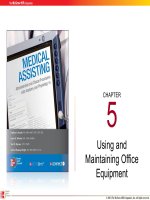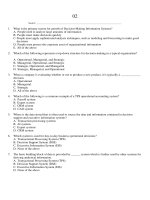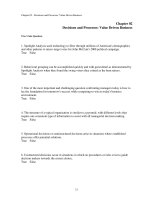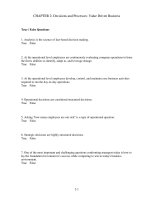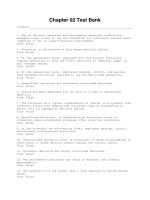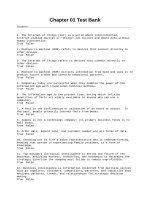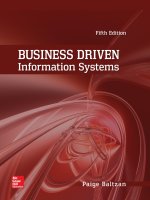Lecture Business driven information systems (4/e): Chapter 5 - Paige Baltzan
Bạn đang xem bản rút gọn của tài liệu. Xem và tải ngay bản đầy đủ của tài liệu tại đây (1.33 MB, 40 trang )
1
CHAPTER FIVE
INFRASTRUCTURES
SUSTAINABLE
TECHNOLOGIES
© 2014 by McGraw-Hill Education. This is proprietary material solely for authorized instructor
use. Not authorized for sale or distribution in any manner. This document may not be copied,
scanned, duplicated, forwarded, distributed, or posted on a website, in whole or part.
2
CHAPTER OVERVIEW
SECTION 5.1 – MIS INFRASTRUCTURE
• The Business Benefits of a Solid MIS Infrastructure
• Supporting Operations: Information MIS Infrastructure
• Supporting Change: Agile MIS Infrastructure
SECTION 5.2 – BUILDING SUSTAINABLE MIS
INFRASTRUCTURES
• MIS and the Environment
• Supporting the Environment: Sustainable MIS
Infrastructure
3
SECTION 5.1
MIS
Infrastructures
© 2014 by McGraw-Hill Education. This is proprietary material solely for authorized instructor
use. Not authorized for sale or distribution in any manner. This document may not be copied,
scanned, duplicated, forwarded, distributed, or posted on a website, in whole or part.
4
LEARNING OUTCOMES
1. Explain MIS infrastructure and its three
primary types
2. Identify the three primary areas associated
with an information MIS infrastructure
3. Describe the characteristics of an agile MIS
infrastructure
5
THE BUSINESS BENEFITS OF A
SOLID MIS INFRASTRUCTURE
MIS infrastructure – Includes the plans for how
a firm will build, deploy, use, and share its data,
processes, and MIS assets
•
•
•
•
•
Hardware
Software
Network
Client
Server
6
THE BUSINESS BENEFITS OF A
SOLID MIS INFRASTRUCTURE
Supporting operations
• Information MIS infrastructure
Supporting change
• Agile MIS Infrastructure
Supporting the environment
• Sustainable MIS infrastructure
7
SUPPORTING OPERATIONS:
INFORMATION MIS INFRASTRUCTURE
Backup and recovery plan
Disaster recovery plan
Business continuity plan
8
Backup and Recovery Plan
Backup – An exact copy of a system’s
information
Recovery – The ability to get a system up and
running in the event of a system crash or failure
• Fault tolerance
• Failover
• Failback
9
Backup and Recovery Plan
Disaster recovery plan - A detailed
process for recovering information or an
IT system in the event of a catastrophic
disaster such as a fire or flood
Disaster recovery cost curve - Charts
(1) the cost to the organization of the
unavailability of information and
technology and (2) the cost to the
organization of recovering from a
disaster over time
10
Backup and Recovery Plan
11
Backup and Recovery Plan
Hot site - A separate and fully equipped
facility where the company can move
immediately after a disaster and resume
business
Cold site - A separate facility that does not
have any computer equipment, but is a
place where employees can move after a
disaster
Warm site – A separate facility with
computer equipment that requires
installation and configuration
12
Business Continuity Plan
Business continuity
planning (BCP) - A plan for
how an organization will
recover and restore partially
or completely interrupted
critical function(s) within a
predetermined time after a
disaster or extended
disruption
13
Business Continuity Plan
Emergency – a sudden
unexpected event
requiring immediate
action
Emergency
preparedness – ensures
a company is ready to
respond to an
emergency in an
organized, timely, and
effective manner
14
Business Continuity Plan
15
Business Continuity Plan
Business impact analysis – Identifies all critical business
functions and the effect that a specific disaster may have
upon them
Technology failure – occurs when the ability of a company to
operate is impaired because of a hardware, software, or data
outage
Incident – Unplanned interruption of a service
Incident management – the process responsible for
managing how incidents are identified and corrected
16
SUPPORTING CHANGE: AGILE
MIS INFRASTRUCTURE
Characteristics of an agile MIS infrastructure
•
•
•
•
•
•
•
Accessibility
Availability
Maintainability
Portability
Reliability
Scalability
Usability
17
Accessibility
Accessibility - Refers to the varying
levels that define what a user can
access, view, or perform when
operating a system
Web accessibility – Allows people
with disabilities to use the Web
Administrator access – Unrestricted
access to the entire system
18
Availability
Availability – Time frames when the
system is operational
Unavailable – Time frames when a
system is not operating and cannot be
used
High availability – System is
continuously operational at all times
19
Maintainability
Maintainability – How quickly a system
can transform to support environmental
changes
Organizations must watch today’s
business, as well as tomorrow’s, when
designing and building systems
Systems must be flexible enough to
meet all types of business changes
20
Portability
Portability – The ability of an application to
operate on different devices or software
platforms
21
Reliability
Reliability - Ensures a system is
functioning correctly and providing
accurate information
Reliability is another term for
accuracy when discussing the
correctness of systems within the
context of efficiency IT metrics
Vulnerability – a system weakness
that can be exploited by a threat
22
Scalability
Scalability - How well a system can
scale up, or adapt to the increased
demands of growth
Performance - Measures how quickly a
system performs a process or transaction
Capacity planning - Determines future
environmental infrastructure
requirements to ensure high-quality
system performance
23
Usability
Usability – The degree to which a
system is easy to learn and efficient
and satisfying to use
Serviceability – How quickly a
third-party can change a system to
ensure it meets user needs and the
terms of any contracts, including
agreed levels of reliability,
maintainability, or availability
24
SECTION 5.2
Building
Sustainable
MIS
Infrastructures
© 2014 by McGraw-Hill Education. This is proprietary material solely for authorized instructor
use. Not authorized for sale or distribution in any manner. This document may not be copied,
scanned, duplicated, forwarded, distributed, or posted on a website, in whole or part.
25
LEARNING OUTCOMES
4. Identify the environmental impacts associated
with MIS
5. Explain the three components of a sustainable
MIS infrastructures along with their business
benefits
